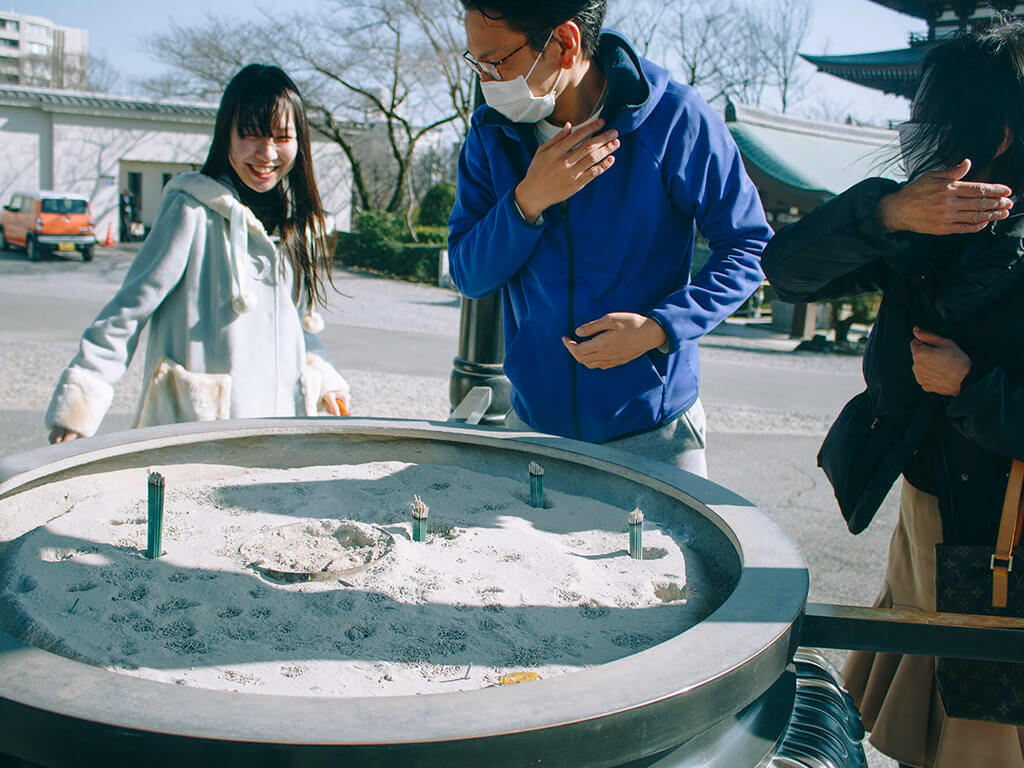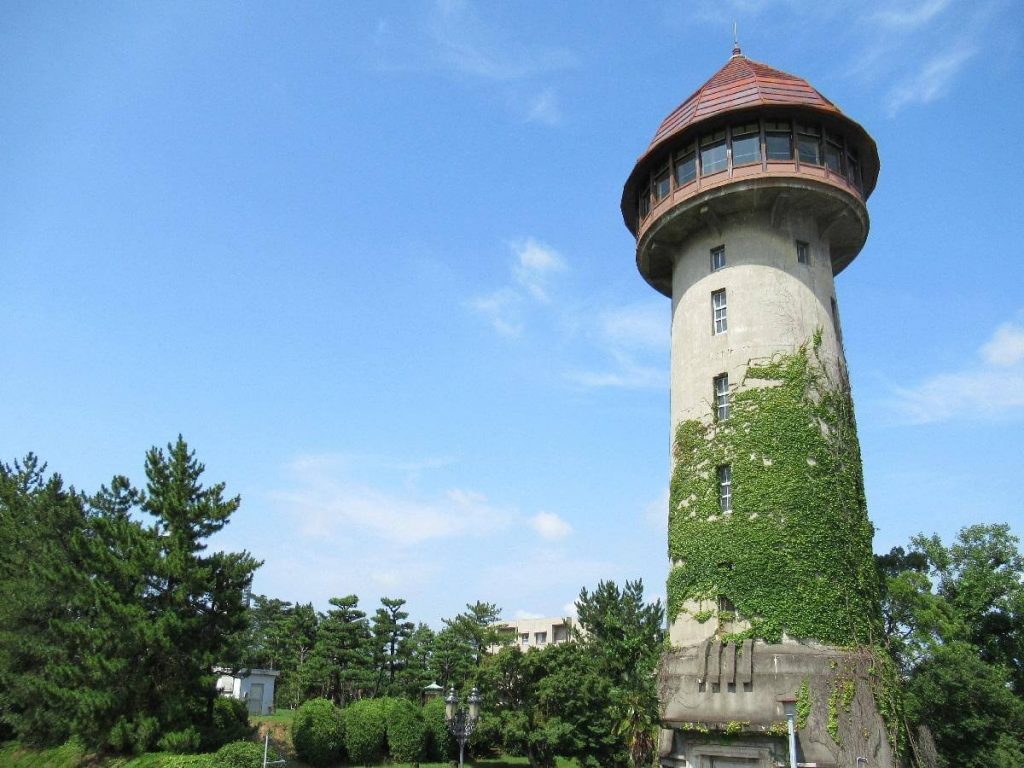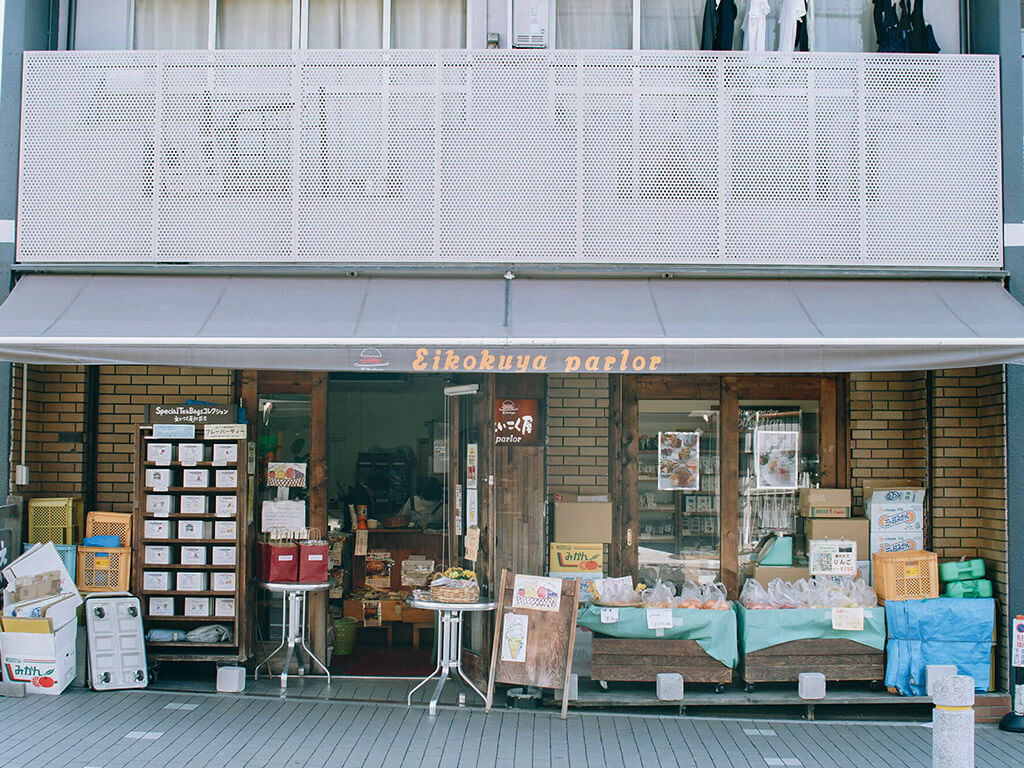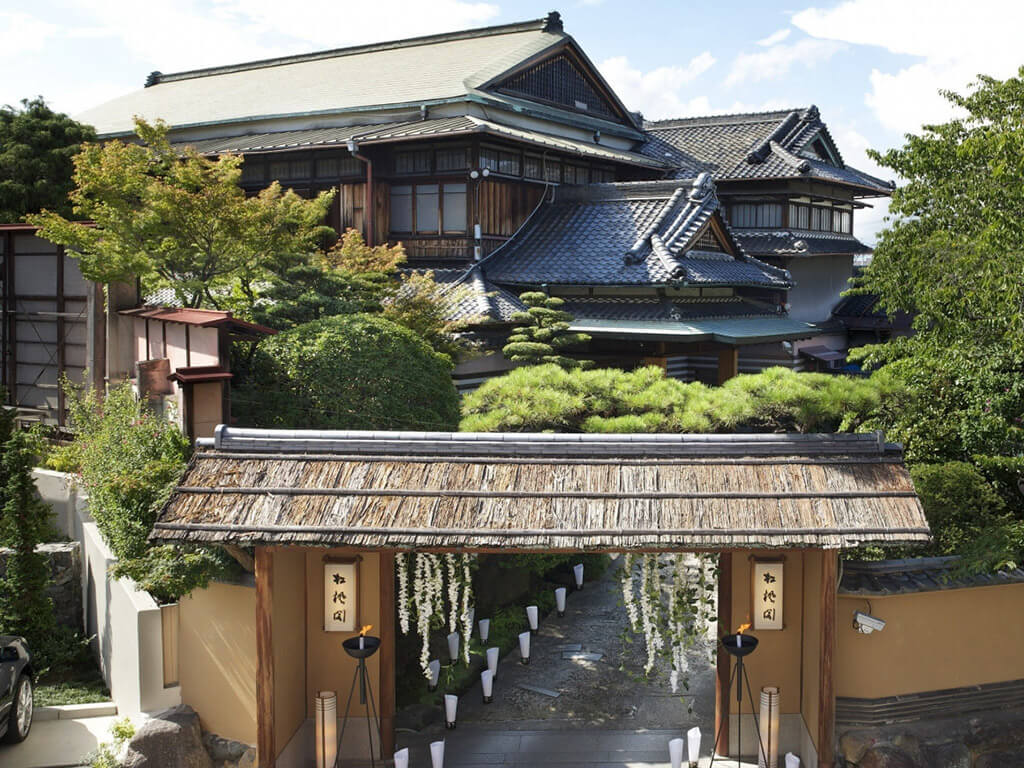The Buddha’s ashes, an old villa, and modern delicacies.
All of these can be found in Kakuozan, a contemporary and artistic district of Nagoya city. This area extends half a kilometer from Kakuozan Station all the way to Nittaiji temple, which enshrines some ashes of the Buddha (yes, the actual Buddha!) bestowed by the king of Thailand.
The popular area features historic architecture from the Showa era (1926-1989), alongside more contemporary buildings. We (Lena and I) think the area’s artisanal shops are an excellent place to hunt for that elusive perfect souvenir, and the many restaurants invite you for lunch or dinner.
The Kakuozan district slopes uphill from the station and was traditionally famous as an excellent place to watch the moon, hence the area’s old name of Tsukimi Zaka or Moon-viewing Hill.
Article Contents
Nittaiji Temple: The Center of Buddhism in Japan
The Nittaiji temple is a Buddhist temple located at the heart of Kakuozan. Uniquely, Nittaiji does not belong to any particular Buddhist sect but represents them all.
In 1898, a pot containing the Buddha’s ashes (563 BC-483 BC) was found by a British archaeologist in India. A year later, Britain transferred the ashes to Thailand, the only independent Buddhist country in the world at that time. In 1900 the ashes were divided into eight parts that were distributed to several Buddhist countries in the world, including Japan.
Nittaiji temple was built in 1904 as a symbol of friendship between Japan and Thailand. The sacred remains of the Buddha, a gift to the people of Japan from the Thai Royal Family, are housed in a stone stupa completed in 1918, which is a Cultural Property of the Prefecture.
The name Kakuozan reflects the importance of this event. Kakuo being an old name for Buddha, and Zan meaning mountain. Kakuozan is Buddha’s Mountain.
Main Gate

Two imposing statues flank the temple’s great main gate. To the left is an image of Kasho-sonja, who was the oldest disciple of Buddha and became the head of Buddhism after the death of Buddha. On the right is the image of Anan-sonja, who was the Buddha’s cousin and was his disciple for 25 years.
Five-Story Pagoda

This beautiful five-story pagoda, about 30 meters high, is next to the water purification basin, close to the main temple. It’s particularly scenic in early April when the cherry blossom trees in the temple grounds are in bloom.
Large Incense Burner

Visitors to Japanese temples traditionally burn incense in large incense burners. The big metal burner at the center of Nittaiji is a beautiful example.
Main Hall

A complete silence floods the interior of the temple. Ceremonies are often held in the mornings and around midday; the monks pray and play sacred instruments. We recommend watching a ceremony if there’s one at the time of your visit – admission is free, but please remember to be quiet during the ceremony.

Morning Market

A morning market is held on the 21st of every month. The market stretches from Kakuozan Station to Nittaiji temple and into the temple grounds. Stalls are selling a wide variety of goods – you can pick up daily products, candles, Japanese pickles, clothes, kitchen knives, fresh fish and seafood, dried fruits, vegetables, flowers, and much more! It starts around 9:00 in the morning and ends at 2:00 p.m. Some small sanctuaries also open their doors to visitors on this day.
Nittaiji Temple (日泰寺)
Entry Fee: free
Opening Hours: Always open, Temple buildings open between 05:00 and 16:30
Address: 1−1 Hoo-cho, Chikusa Ward, Nagoya, Aichi 464-0057
Access: From Nagoya Station, take the Higashiyama Subway line to Kakuozan. From there, it’s a 10-minute walk.
Website | Google Maps
The Life of the Rich and Famous in Pre-War Nagoya at Yokiso Villa

This luxurious residence was built over twenty years, starting in 1918, for the prestigious Matsuzakaya department store president. In the late 1930s, the villa’s sprawling grounds held around 30 buildings – Yokiso wasn’t just a home but a place to entertain guests and for cultural exchange. Visitors ranged from members of the Imperial family to celebrities, business tycoons, and politicians. It wasn’t just the rich who were welcome at Yokiso; there was also a hostel used by Asian students studying in Japan. Sadly the pre-war opulence of Yoki-so has been diminished by neighborhood development, the ravages of time, and the effects of World War II. Still, some of the major buildings survive today.
Choshokaku

One of the last buildings to be completed at Yoki-so, this reception hall is a delightful blend of various architectural styles. From the outside, you’d be forgiven for thinking you’re in an Alpen village – Choshokaku’s half-timbered frontage is modeled on European mountain lodges. Inside, though, it’s a mix of Western and Eastern styles; the rooms now house exhibitions on the history of Yoki-so and a café, where you can relax and enjoy views of the garden. Don’t miss the basement and its Indian decorations, painted by the Indian students who once lived here.
English speaking guides are available.
North Garden and Hakuun Bridge

This strolling pond garden is modeled on the Shugakuin Imperial Villa in Kyoto and provides a welcome respite from its urban surroundings. A highlight is the seasonal foliage, ensuring that you’ll get a new view every time you visit, such as cherry blossoms in spring, the fresh green of summer, or the stunning golden maples in the fall. The Hakuun Bridge is an elaborately decorated corridor bridge, a Cultural Asset of Nagoya city, and a great place to take photographs.
Yokiso Villa (揚輝荘)
Opening hours: 9:30 to 16:30, closed Mondays, the weekday following a national holiday, and Dec. 29 to Jan. 3
Entry Fee: 300 yen for Choshokaku, free for junior high school students and younger
Address: 2-5-17 Hoo-cho, Chikusa Ward, Nagoya, Aichi 464-0057
Access: From Nagoya Station, take the Higashiyama Subway line to Kakuozan. From there, it’s a 10-minute walk.
Website | Google Map
More Interesting Landmarks to Discover on a Walk Around Kakuozan
Shiroyama Hachimangu Shrine and Remains of Suehiro Castle

Located not far from Kakuozan, this historic Shinto shrine is situated atop a small hill and surrounded by trees, providing a nice break from the urban sprawl of Nagoya. Don’t miss the so-called Marital Tree, a huge tree trunk that splits and rejoins with itself – this is worshipped as a symbol of happy marriages and relationships. The mound once played host to Suehiro Castle, a 16th-century Samurai fortress, but little remains of the castle today.
Shiroyama Hachimangu Shrine (城山八幡宮)
Entry Fee: Free
Opening hours: Always open (Shrine reception open daily 09:15-16:30)
Address: 2-88 Shiroyamacho, Chikusa Ward, Nagoya, 464-0045
Access: From Nagoya Station, take the Higashiyama Subway line to Kakuozan. From there, it’s a 10-minute walk.
Website (Japanese only) | Google Map
Historical Museum of Waterworks and Sewerage and Higashiyama Water Tower

Delve into the history of Nagoya’s plumbing in this unusual museum, dedicated to waterworks engineering. Four display rooms trace the development of Nagoya’s waterworks from the 19th century to the present day – keeping this huge city clean and well-watered is a surprisingly complex and interesting task! If you happen to visit on either the spring equinox or August the 8th, the nearby Higashiyama Water Tower is open for visitors only on these days. It provides splendid views of Kakuozan and the Nagoya area.
Historical Museum of Waterworks and Sewerage (水の歴史資料館)
Entry Fee: free
Opening Hours: 9:30 to 16:30, closed Mondays, the weekday following a national holiday, and Dec. 29 to Jan. 3
Address: 1-1-44 Tsukigaoka, Chikusa Ward, Nagoya, Aichi 464-0043
Access: From Nagoya Station, take the Higashiyama Subway line to Kakuozan. From there, it’s a 20-minute walk.
Website (Japanese Only) | Google Maps
Our Personal Shopping & Dining Recommendations in Kakuozan
Kakuozan contains many cozy local eateries and places for shopping. Here are some of our recommendations:
Eikokuya Tea Parlor

One of our favorite places is the Eikokuya Parlor tea shop. This shop has a wide variety of teas from India, Nepal, and Ceylon. Besides tea, Eikokuya Parlor also sells 100% natural dried fruit (sugar-free) to enjoy with your tea.
Eikokuya Tea Parlor (えいこく屋)
Opening Hours: 10:00-19:00, closed Tuesdays, New Year, and August Obon holidays
Address: 2−58 Sanmoncho, Chikusa Ward, Nagoya, Aichi 464-0064
Access: From Nagoya Station, take the Higashiyama Subway line to Kakuozan. From there, it’s a 1-minute walk.
Website (Japanese Only) | Google Maps
Chez Shibata Cakes and Cafe

Also on this same street is the Chez Shibata pastry shop. Chez Shibata is one of the most famous pastry-chocolatiers in Japan and is recognized worldwide. Chez Shibata has a special style of pastry that combines a classic French pastry with Japanese craftsmanship and technique. The cakes aren’t just eye-catching – they’re also delicious!
Chez Shibata Cakes and Cafe (シェ・シバタ 名古屋店)
Opening Hours: 10:00-19:30, closed Tuesdays
Address: 2−54 Sanmoncho, Chikusa Ward, Nagoya, Aichi 464-0064
Access: From Nagoya Station, take the Higashiyama Subway line to Kakuozan. From there, it’s a 1-minute walk.
Website | Google Maps
Kakuozan Apartment

Kakuozan Apartment is located on Kakuozan’s main shopping street. Originally it was an old wooden department store, but it has been renovated and converted into a shared space for various local artists to work and sell their products. There are unique craft shops, clothing boutiques, and even a second-hand bookshop.

Depending on the season, there are work exhibitions of art and photography. You also have the opportunity to try any handicraft workshop that is offered there. And don’t miss the second floor!
Kakuozan Apartment (シェ・シバタ 名古屋店)
Opening Hours: 11:00–18:00, closed Tuesdays and Wednesdays
Address: 1-13 Sanmoncho, Chikusa Ward, Nagoya, Aichi 464-0064
Access: From Nagoya Station, take the Higashiyama Subway line to Kakuozan. From there, it’s a 1-minute walk.
Website (Japanese Only) | Google Maps
Eikokuya Curry Restaurant

We highly recommend this well-known Indian curry restaurant. Curry types include spinach curry, chickpea curry, and green banana curry (one of our favorites). Accompany your curry with a giant naan (Indian bread) for maximum deliciousness!
Eikokuya Indian Restaurant (えいこく屋 インド料理店)
Opening Hours: 10:00-20:30 (Closed on Tuesdays, New Year, and August Obon holidays)
Address: 2−58 Sanmoncho, Chikusa Ward, Nagoya, Aichi 464-0064
Access: From Nagoya Station, take the Higashiyama Subway line to Kakuozan. From there, it’s a 1-minute walk.
Website (Japanese Only) | Google Maps
Shofukaku Restaurant

Stepping in here is like visiting traditional Japan – this restaurant is nearly one hundred years old and has survived wars and typhoons unscathed. The central garden complements the restrained beauty of the interior, and private-use rooms ensure that your dining experience will be undisturbed and restful. Luxury does come with a price, though; reservations are required, and even the cheaper lunch courses start at 7,700 yen.
Shofukaku (松楓閣)
Opening Hours: Lunch 11:00 to 14:00, Dinner from 17:00
Address: 2-3 Sanmon-cho, Chikusa-ku, Nagoya, Aichi 464-0064
Access: From Nagoya Station, take the Higashiyama Subway line to Kakuozan. From there, it’s a 3-minute walk.
Website | Google Maps
Zarame Nagoya

Zarame is a small, trendy cafe that is famous for its donuts. When you walk in, the first thing you notice is the large display case on the left-hand side filled with delicious-looking donuts. You are welcome to purchase a donut to-go or to get a seat inside. In addition to donuts, the cafe serves burgers and Japanese curry. Zarame can be very busy around lunchtime and on the weekends, so if you want to make sure you have the largest selection of donuts possible before they sell out we recommend trying to visit early.
Zarame Nagoya (Zarame Nagoya)
Opening Hours: 9:00-20:00
Address: 2-36 Sanmon-cho, Chikusa-ku, Nagoya, Aichi 464-0064
Access: From Nagoya Station, take the Higashiyama Subway line to Kakuozan. From there, it’s a 3-minute walk.
Website (Japanese Only) | Google Maps
Come And See Kakuozan’s Exciting Festivals

Kakuozan celebrates three important festivals every year; Spring, Summer, and Autumn. The vibrant atmosphere of these festivals encompasses live music, multicultural food stalls, an antique market, craft workshops for all ages, and more. The street leading from Kakuozan Station all the way to Nittaiji Temple is lined with a wide variety of stalls offering fun for the whole family. Events run from about 10:00 to 19:00.
Getting To Kakuozan
Kakuozan is conveniently located on the Higashiyama subway line. From Nagoya Station it’s a 14 minute long ride to Kakuozan Station. Take Exit 4 to get to the main shopping district and Nittaiji Temple.
Photo credit: Elisabeth Llopis @ellpcreative










Kakuozan Summer festival. On what dayes is the festival?
The festival dates for this year: April 8 and 9, 2023